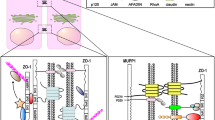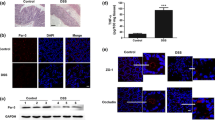ABSTRACT
Purpose
Poly-L-arginine (PLA) enhances the paracellular permeability of the Caco-2 cell monolayer to hydrophilic macromolecules by disappearance of tight junction (TJ) proteins from cell–cell junctions. However, the mechanism of the disappearance of TJ proteins in response to PLA has been unclear. In this study, we investigated the mechanism of disappearance of TJ proteins from cell–cell junctions after the application of PLA to Caco-2 cell monolayers.
Methods
The membrane conductance (Gt), FITC-dextran (FD-4) permeability, and localization of TJ proteins were examined after the treatment of Caco-2 cell monolayers with PLA in the presence of various endocytosis inhibitors. In addition, the localization of endosome marker proteins was also observed.
Results
Clathrin-mediated endocytosis inhibitors suppressed the increase in Gt and Papp of FD-4 induced by PLA, and also significantly suppressed the disappearance of TJ proteins induced by PLA. Furthermore, occludin, one of the TJ proteins, colocalized with early endosome and recycling endosomes after the internalization of occludin induced by PLA, and then was recycled to the cell–cell junctions.
Conclusion
PLA induced the transient internalization of TJ proteins in cell–cell junctions via clathrin-mediated endocytosis, subsequently increasing the permeability of the Caco-2 cell monolayer to FD-4 via a paracellular route.







Similar content being viewed by others
References
Westergren I, Johansson BB. Altering the blood–brain barrier in the rat by intracarotid infusion of polycations: a comparison between protamine, poly-L-lysine and poly-L-arginine. Acta Physiol Scand. 1993;149(1):99–104.
Kotze AF, Luessen HL, de Leeuw BJ, deBoer AG, Verhoef JC, Junginger HE. Comparison of the effect of different chitosan salts and N-trimethyl chitosan chloride on the permeability of intestinal epithelial cells (Caco-2). J Control Release. 1998;51(1):35–46.
Sandri G, Poggi P, Bonferoni MC, Rossi S, Ferrari F, Caramella C. Histological evaluzation of buccal penetration enhancement properties of chitosan and trimethyl chitosan. J Pharm Pharmacol. 2006;58(10):1327–36.
McEwan G, Jepson M, Hirst BH, Simmons NL. Polycation-induced enhancement of epithelial paracellular permeability is independent of tight junctional characteristics. Biochim Biophys Acta. 1993;1148(1):51–60.
Artursson P, Lindmark T, Davis SS, Illum L. Effect of chitosan on the permeability of monolayers of intestinal epithelial cells (Caco-2). Pharm Res. 1994;11(9):1358–61.
Natsume H, Iwata S, Ohtake K, Miyamoto M, Yamaguchi M, Hosoya K, et al. Screening of cationic compounds as an absorption enhancer for nasal drug delivery. Int J Pharm. 1999;185(1):1–12.
Ohtake K, Maeno T, Ueda H, Ogihara M, Natsume H, Morimoto Y. Poly-L-arginine enhances paracellular permeability via serine/threonine phosphorylation of ZO-1 and tyrosine dephosphorylation of occludin in rabbit nasal epithelium. Pharm Res. 2003;20(11):1838–45.
Furuse M, Itoh M, Hirase T, Nagafuchi A, Yonemura S, Tsukita S, et al. Direct association of occludin with ZO-1 and its possible involvement in the localization of occludin at tight junctions. J Cell Biol. 1994;127(6 Pt 1):1617–26.
Furuse M, Fujita K, Hiiragi T, Fujimoto K, Tsukita S. Claudin-1 and -2: novel integral membrane proteins localizing at tight junctions with no sequence similarity to occludin. J Cell Biol. 1998;141(7):1539–50.
Furuse M, Sasaki H, Fujimono K, Tsukita S. A single gene product, claudin-1 or -2, reconstitutes tight junction strands and recruits occludin in fibroblasts. J Cell Biol. 1998;143(2):391–401.
Simon DB, Lu Y, Choate KA, Velazquez H, AL-Sabban E, Praga M, et al. Paracellin-1 a renal tight junction protein required for paracellular Mg2+ resorption. Science. 1999;285(5424):103–6.
Al-Sadi R, Khatib K, Guo S, Youssef M, Ma T. Occludin regulates macromolecule flux across the intestinal epithelial tight junction barrier. Am J Physiol Gastrointest Liver Physiol. 2011;300(6):G1054–64.
Ikenouchi J, Furuse M, Furuse K, Sasaki H, Tsukita S, Tsukita S. Tricellulin constitutes a novel barrier at tricellular contacts of epithelial cells. J Cell Biol. 2005;171(6):939–45.
Yamaki T, Ohtake K, Ichikawa K, Uchida M, Uchida H, Ohshima S, et al. Poly-L-arginine-induced internalization of tight junction proteins increases the paracellular permeability of the Caco-2 cell monolayer to hydrophilic macromolecules. Biol Pharm Bull. 2013;36(3):432–41.
Murakami T, Felinski EA, Antonetti DA. Occludin phosphorylation and ubiquitination regulate tight junction trafficking and vascular endothelial growth factor-induced permeability. J Biol Chem. 2009;284(31):21036–46.
Ivanov AL, Nusrat A, Parkos CA. Endocytosis of epithelial apical junctional proteins by a clathrin-mediated pathway into a unique storage compartment. Mol Biol Cell. 2004;15(1):176–88.
Stamatovic SM, Keep RF, Wang MM, Jankovic I, Andjelkovic AV. Caveolae-mediated internalization of occludin and claudin-5 during CCL2-induced tight junction remodeling in brain endothelial cells. J Biol Chem. 2009;284(28):19053–66.
Bruewer M, Utech M, Ivanov AL, Hopkins AM, Parkos CA, Nusrat A. Interferon-gamma induces internalization of epithelial tight junction proteins via a macropinocytosis-like process. FASEB. 2005;19(8):923–33.
Conner SD, Schmid SL. Regulated portals of entry into the cell. Nature. 2003;422(6927):37–44.
Utech M, Mennigen R, Bruewer M. Endocytosis and recycling of tight junction proteins in inflammation. J Biomed Biotechnol. 2010;2010:484987.
Liu J, Kesiry R, Periyasamy SM, Malhotra D, Xie Z, Shapiro JI. Ouabain induces endocytosis of plasmalemmal Na/K-ATPase in LLC-PK1 cells by a clathrin-dependent mechanism. Kidney Int. 2004;66(1):227–41.
Kim Y, Kugler MC, Wei Y, Kim KK, Li X, Brumwell AN, et al. Integrin alpha3beta1-dependent beta-catenin phosphorylation links epithelial Smad signaling to cell contacts. J Cell Biol. 2009;184(2):309–22.
Seki T, Kiuchi T, Seto H, Kimura S, Egawa Y, Ueda H, et al. Analysis of the rat skin permeation of hydrophilic compounds using the Renkin function. Biol Pharm Bull. 2010;33(11):1915–8.
Seth A, Sheth P, Elias BC, Rao R. Protein phosphatases 2A and 1 interact with occludin and negatively regulate the assembly of tight junctions in the CACO-2 cell monolayer. J Biol Chem. 2007;282(15):11487–98.
Mohammad-Panah R, Ackerley C, Rommens J, Choudhury M, Wang Y, Bear CE. The chloride channel CIC-4 co-localizes with cystic fibrosis transmembrane conductance regulator and may mediate chloride flux across the apical membrane of intestinal epithelia. J Biol Chem. 2002;277(1):566–74.
Al-Sadi RM, Ma TY. IL-1beta causes an increase in intestinal epithelial tight junction permeability. J Immunol. 2007;178(7):4641–9.
Ye D, Guo S, Al-Sadi R, Ma TY. MicroRNA regulation of intestinal epithelial tight junction permeability. Gastroenterology. 2011;141(4):1323–33.
Author information
Authors and Affiliations
Corresponding author
Rights and permissions
About this article
Cite this article
Yamaki, T., Kamiya, Y., Ohtake, K. et al. A Mechanism Enhancing Macromolecule Transport Through Paracellular Spaces Induced by Poly-L-Arginine: Poly-L-Arginine Induces the Internalization of Tight Junction Proteins via Clathrin-Mediated Endocytosis. Pharm Res 31, 2287–2296 (2014). https://doi.org/10.1007/s11095-014-1324-4
Received:
Accepted:
Published:
Issue Date:
DOI: https://doi.org/10.1007/s11095-014-1324-4




